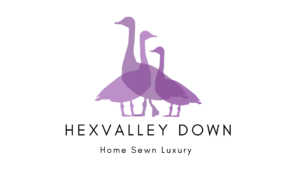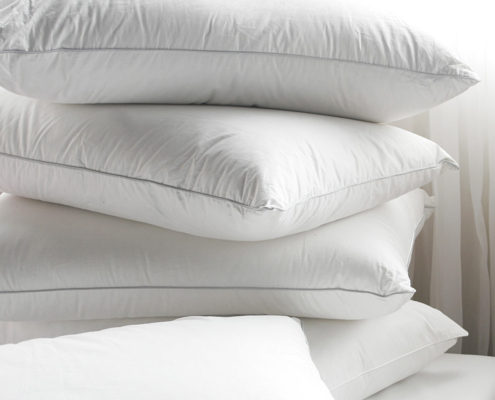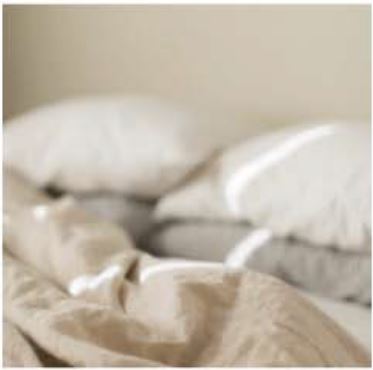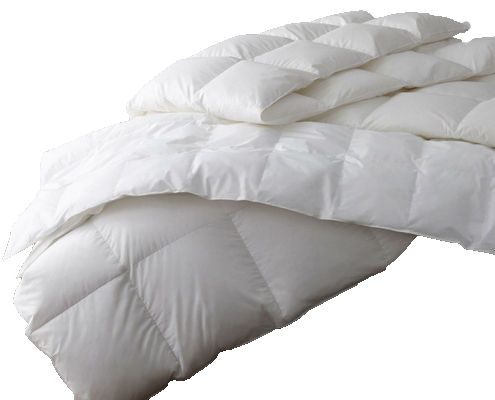© Copyright – Hex Valley Down | Website Developed by Tiny Giant Studios
Selecting your Duvet
We offer 3 types of luxurious seasonal goose down duvets that come in a selection of size preferences. Upon special request, we can provide custom made duvets. All duvets are produced with a 100% pure, silky and smooth cotton percale that has a lifetime guarantee.
Seasonal duvets to consider:
1. Winter:
The optimum lightweight warmth. Our winter goose duvets provide the most heat during the colder months. With its full density, we make use of the tunnel construction to ensure that the down filling remains in place while allowing the down clusters to expand to its fullest loft potential.
2. Autumn:
The ‘all season’ duvet. Not too hot, nor too cold. We have designed these duvets bearing in mind that the down clusters need to expand to their fullest loft potential in order to provide maximum sleeping comfort through proper insulation.
3. Summer:
The lightweight duvet for those balmy summer days. These duvets we have designed with stitched-through box construction to ensure that the down filling stays in place whilst being perfectly distributed and allowing maximum loft potential of the down clusters.
Selecting your Pillows
At Hex Valley Down, are well aware of the value of a good night’s rest, we have compiled a short guide to help you choose the perfect pillow. Before you make your choice, consider the position you sleep in. The ultimate function of a pillow is to help keep your head in a neutral alignment with your spine, not bent too far forward or backward.
- Sleeping on your side: Consider a firm pillow to wholly fill up the space between the side of your face and shoulder.
- Sleeping on your back: Consider a softer pillow that will not force or elevate your head too far forward.
- Sleeping on your stomach: Consider a soft and thin pillow which you could ultimately use as support underneath your stomach to prevent the occurrence of back pain.
Selecting Your Sleeping Bags
Whether a first time camper, a light backpacker exploring the world out there or an adventurer taking on the high altitude mountains, Hex Valley Down is committed to helping create comfort for those everlasting precious memories. Our sleeping bags are filled with thoroughly washed, sterilized and allergy-treated 100% pure down. Our pertex sleeping bags are made only in the mummy shape. It is complete with a full-length two-way zip – allowing maximum movement for easy comfort. The standard length of the bag is 2 m (2.2 m with the hood included). The bag has a collar baffle as well as a zip baffle to prevent cold air from penetrating. The stuff bag is included. We also supply ripstop/cotton sleeping bags in either a mummy or rectangular shape in accordance with customer specifications, with ripstop nylon on the outer side and down-proof cotton on the inner side. We offer our sleeping bags in a wide range of colours and are subject to availability.
1. Venture
It is important to choose a bag according to the activity you’re going to do most often. Are you planning a basic camping trip in a tent or camper, long distance trekking, high altitude mountaineering or going on hunting expeditions etc. Your exposure to the elements differ in all of these situations and therefore the application of the sleeping bag is different.
- Choosing a bag for camping or hunting expeditions
Here the emphasis is on comfort. If you have ample space and weight is of no concern, choose the shape that fits you the most comfortably and that has a temperature rating warm enough to sustain you whether you’re planning your trip in the heat of summer or in the middle of a brutal winter. A typical winner in this category is our rectangular bags.
- Choosing a bag for trekking
The perfect bag for trekking long distances or hiking up into the mountains, is the one where weight, compressibility and warmth are well balanced. You need a bag that won’t weigh a ton and doesn’t take up all your pack space yet will be warm enough to ensure comfort in the outdoors where you’re exposed to the various elements. Our mummy shaped sleeping bags cut out unnecessary centimetres that would’ve added to extra weight and size.
- Choosing a bag for high altitude mountaineering
Your pack size and -weight are vital in the mountains, so your options are narrowed down to those bags offering more features enhancing compressibility and warmth. These features include water resistant/breathable fabrics, added baffles, hoods, the best quality insulation available (which inevitably means a higher fill power down).
2. Temperature ratings
This refers to the lowest temperature at which your bag can be used to sleep in and stay comfortable whilst using a sleeping pad. For guidance, you can use the pointers below:
- Summer bags: 20 degrees and up
- Standard/3-Season bags: 0 – 25 degrees
- Expedition bags: below 0 degrees
Our standard bag is highly adaptable and can handle most weather conditions well. Unzipping your bag to air your feet or when the temperatures take a dive, layering up or using a liner can buy a few extra degrees of warmth.
3. Down vs synthetics
Even though we only supply goose down filled bags, we find it worthwhile to add some info on the differences between down and synthetics. There isn’t much out there that can top the insulation superiority of goose down. It is warm, yet weighs little, it has the capability to compress into the smallest of balls without losing its ability to loft and has longevity that synthetics cannot get close to. What tips the scales back in favour of synthetics though, is the ability to retain your heat even when it’s soaked, it dries out fast and is much more affordable. Still, all of that said, synthetics cannot equal the many advantages of pure down bearing in mind that keeping your bag dry during wet conditions isn’t all that difficult either.
- Fill power
This refers to the numerical analysis of the ability of the down to loft and trap the sleeper’s body heat. Down with a higher fill power can more effectively keep you warm, which means that you’ll need less of it which in turn results in weight saving. All our Hex Valley Down sleeping bags are filled with top of the range locally sourced pure goose down with a fill power of 850+.
4. Shape
- Rectangular
A great choice for recreational camping trips. This spacious bag facilitates comfort sleep at its best, letting you sleep in any position you’d like. Adding to this is the advantage of being able to unzip it fully to be used as a quilt-like cover or zipped to a second bag to create a twin bag. Though these are great perks to be had, simultaneously they give cause to a much bulkier and weighty bag with more fill and fabric used. Unfortunately, as heat gets lost in the dead space created, the insulating properties are compromised to some extent.
- Mummy
Certainly not a favourite for those struggling with claustrophobia, mummy bags however, do make up for it by saving significantly on weight and space, and being a much more efficient insulator as in the snugger fit. If you plan to carry your bag on your back whatever the distance, this is the one to go with.
5. Fabric
Hex Valley Down sleeping bags are made with a finely woven nylon which is showerproof and wind resistant yet breathable. This downproof fabric dries quickly and wicks off moisture. Approximate weight: 55-70 gsm (grams per square metre). We leave you with the choice of using this fabric as shell and liner or as shell only in combination with a cotton liner. What is the difference between a nylon and cotton liner? Cotton weighs more, but is more breathable than nylon.
6. Zips
Zips with larger and more robust teeth don’t snag as easily as its dainty counterparts. The added anti-snag backing along the zip ensures smooth zipping. Also the brand YKK is an added benefit.
7. Anti-draft tube and -collar
The anti-draft tube refers to the insulation filled tube running alongside the full length of the zip to prevent cold drafts from penetrating. This is an essential for all bags other than the summer bag. The anti-draft collar is situated around the neck when the bag is zipped up to prevent heat loss. This is ideal mostly for the expedition bags and can be an option for the standard bags.
8. Baffles
These refer to the down filled chambers inside of the sleeping bag shell which runs horizontally and are boxwalled. Boxwall baffles are the simplest baffle with side walls (vertical walls of lightweight mesh) and are designed to create sufficient space for down to loft fully but not too much space so that the down disperses. This means the inner and outer shells are separated where otherwise heat loss would have occurred as in the case of stitched through baffles. The side wall allows for down to loft better also along the edges and decreases the chances of cold spots.
- Continuous baffles
Being exposed to a much wider range of temperatures, the standard/3 season bags need to be more versatile therefore they can also be built with continuous baffles encircling the bag from zip to zip. This enables you to shift the insulation to the area needed more to maintain a snug temperature inside the bag. For instance, during colder nights, more down can be moved from underneath you to the top to enhance insulation, and vice versa.
- Side block baffles
Found on the opposite side of the zip, this barrier blocks insulation moving from the top of the bag to the bottom
9. Differential cut
This is where the inner lining of a bag is cut smaller than the outer shell fabric as, typically with the mummy bags, the inside of a bag has a smaller circumference than the outside. This promotes better loft through the outward expansion of the insulation which reduces the appearance of cold spots.
10. Hoods
To be considered for bags to be used in colder temperatures. A snug fit is preferable which is obtained through a reverse differential cut. This means that the larger piece of fabric is used for the inside of the hood. The loose down filled fabric surrounds your head creating better insulation without needing to tighten the cord.
11. Ideal size
The length of your bag will be determined by your height, and as a standard we offer the following:
- Extra length: 210cm
- Regular: 200cm
- Short: 180cm
Bear in mind that a bag too short will result in insulation loss due to down being compressed by your head and/or feet. A bag too long has dead space that takes much more time to warm up.
Selecting Pillow Protectors
Investing in quality pillow calls for the need to use a good quality protector. Not only do they extend the life of a pillow by protecting it against the everyday wear and tear, they also promote health and cleanliness. The fabric used for our protectors absorbs any moisture, fluids and oiliness, preventing it from penetrating your pillow and causing stains, discolouring or unpleasant odours. Our protectors are easily removable and can be washed as frequently as the circumstances necessitates without losing its soft feel and breathability. Furthermore, it adds a second barrier to any stubborn feathers poking through the inner casing which may cause some discomfort during sleep.
Selecting Feather beds and toppers
A feather bed (also referred to by some as a topper) is not an actual bed or mattress. Rather, this big and billowy type of bedding is used on top of a mattress in an attempt to soften a firm mattress. Most commonly they are filled with down, feathers or a combination of the two from duck or geese alike. The boxed baffle design ensures that the fill stays where it should whilst also allowing it to fully loft.
To some users, lying on their soft and fluffy feather bed gives them the sensation of sleeping in a warm cloud. Other might experience the thickness does not render adequate cushioning and is uncomfortable as it flattens out when laid upon. As these are mainly filled with feathers, it is not uncommon that the sharp ends poke through the cotton casing.
Feather beds need to be shaken out and fluffed frequently to maintain loft and effectiveness. Get in the habit of fluffing and giving your feather bed a thorough shake every time the fitted sheet or feather bed protector is changed.






